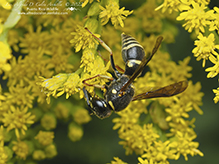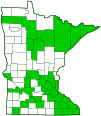potter and mason wasps
(Euodynerus spp.)
Overview • Description • Distribution • Taxonomy
Description |
||
Euodynerus are larger wasps, usually more than ⅜″ (9 mm) long. The body is black with well-developed yellow or ivory (pale) markings, and sometimes also with rust-colored markings, on both the front (mesonotum) and rear (metanotum) parts of the body. There is a pale spot at the base of each jaw (mandible). There is also a pale spot behind each eye, and it is usually small. On the male, the antennae have 13 segments and they are hooked at the end. On the female the antennae have just 12 segments and they are not hooked at the end. On the pronotum there is a raised ridge (transverse carina) on the front margin. The front face of the pronotum does not have two pits in the middle. On the first segment of the abdomen (propodeum), fused to the thorax on all wasps, the rear corners are angled. The propodeum is short, not petiole-like. It is no more than 1.4 times longer than wide, and it is at least 0.7 times as wide as the second segment. On the rear part of the body there is always a pale stripe on the rear margin of the first segment (tergite) and almost always another on the second tergite. The first tergite does not have a transverse carina. |
||
Distribution |
||||
|
Sources |
|||
| 2/21/2023 | ||||
Taxonomy |
|||
Order |
Hymenoptera (Ants, Bees, Wasps, and Sawflies) | ||
Suborder |
Apocrita (Narrow-waisted Wasps, Ants, and Bees) | ||
| No Rank | Aculeata (Ants, Bees, and Stinging Wasps) | ||
Superfamily |
Vespoidea (vespoid wasps) | ||
Family |
Vespidae (hornets, paper wasps, potter wasps, and allies) | ||
Subfamily |
Eumeninae (potter and mason wasps) | ||
Subordinate Taxa |
|||
black-and-white mason wasp (Euodynerus leucomelas) cryptic mason wasp (Euodynerus crypticus) Hidalgo mason wasp (Euodynerus hidalgo) pitted mason wasp (Euodynerus foraminatus) potter or mason wasp (Euodynerus boscii) ringed mason wasp (Euodynerus annulatus) |
|||
Synonyms |
|||
|
|||
Common Names |
|||
This genus has no common name. The common name of the Subfamily Eumeninae is potter and mason wasps, and it is used here for convenience. |
|||
Glossary
Mesonotum
The principal exoskeletal plate on the upper (dorsal) part of the middle segment of the thorax of an insect.
Propodeum
In Hymenoptera: the last segment of the thorax, anatomically the first segment of the abdomen.
Tergite
The upper (dorsal), hardened plate on a segment of the thorax or abdomen of an arthropod or myriapod.
Visitor Photos |
|||||
Share your photo of this insect. |
|||||
| This button not working for you? Simply email us at info@MinnesotaSeasons.com. Attach one or more photos and, if you like, a caption. |
|||||
MinnesotaSeasons.com Photos |
|||||
|
|||||

Slideshows |
||

Visitor Videos |
|||
Share your video of this insect. |
|||
| This button not working for you? Simply email us at info@MinnesotaSeasons.com. Attach a video, a YouTube link, or a cloud storage link. |
|||
Other Videos |
|||
| Hymenoptera of North America Euodynerus |
|||
About
Jul 13, 2022 |
|||
| Euodynerus sp. Potter Wasp margy stewart |
|||
About
Mar 3, 2022 This striking wasp was nectaring on volunteer Hairy Asters in our back yard. Hairy Asters (Symphyotrichum pilosum) are a wildflower of the tallgrass prairie. Geary County, Kansas, October 2021. |
|||

Visitor Sightings |
|||||
Report a sighting of this insect. |
|||||
| This button not working for you? Simply email us at info@MinnesotaSeasons.com. Be sure to include a location. |
|||||
|
|
||||
MinnesotaSeasons.com Sightings |
|||||
|
|||||

Created: 2/21/2023
Last Updated:

